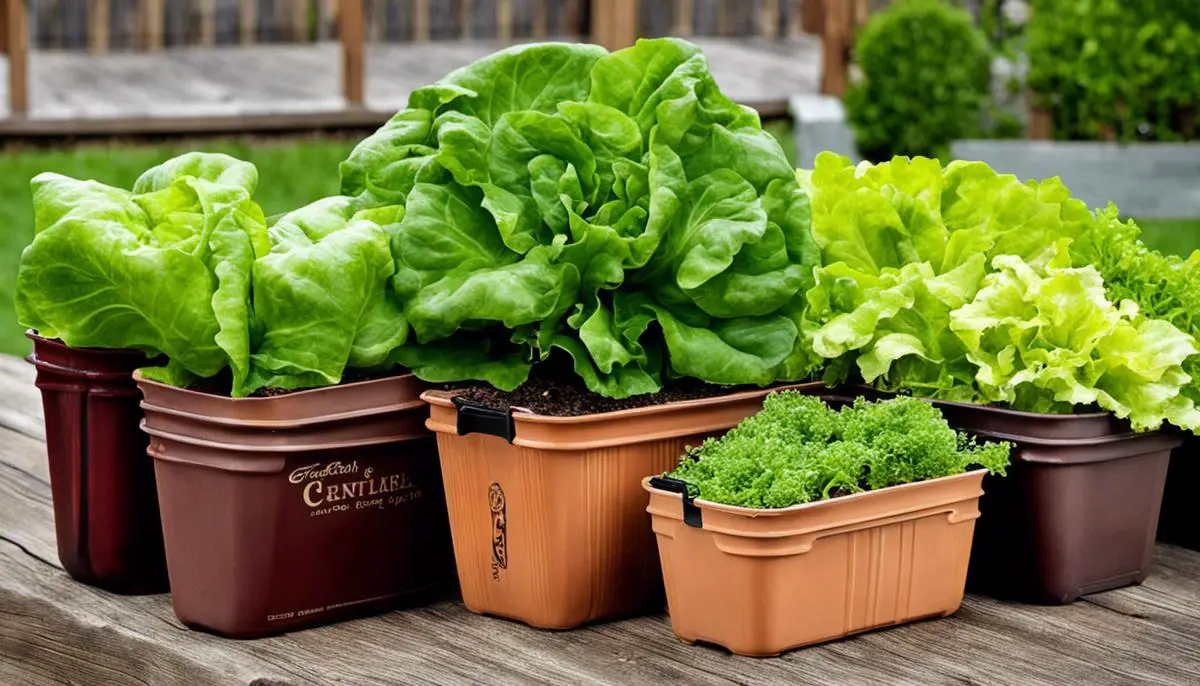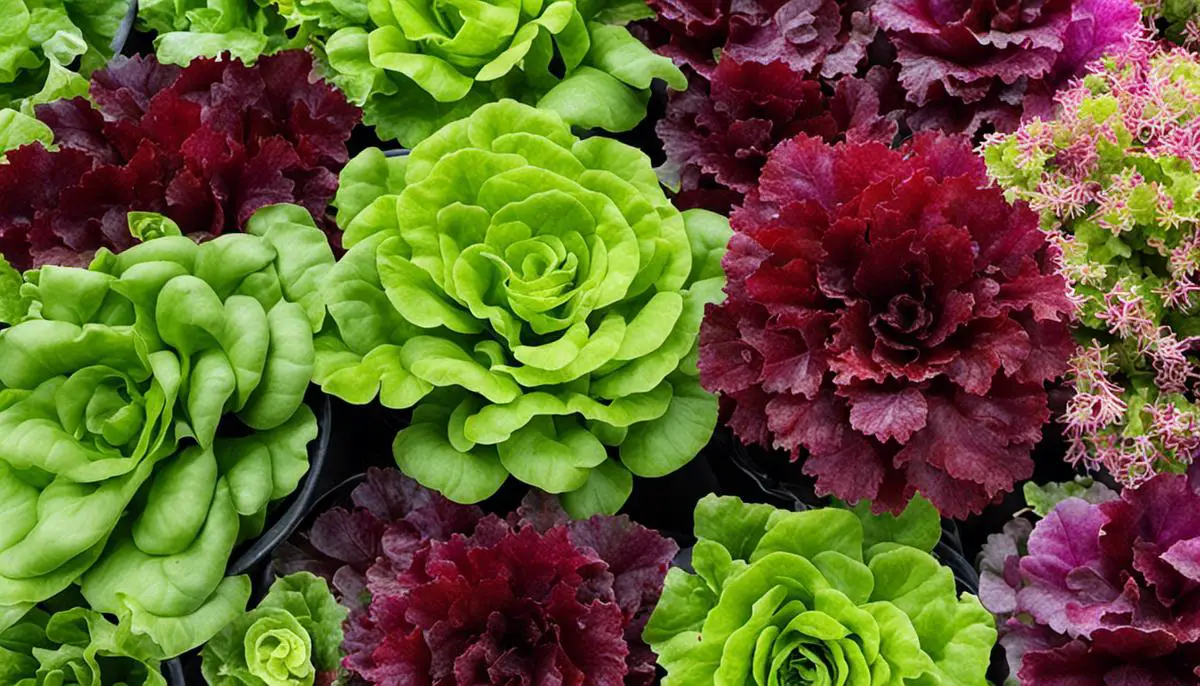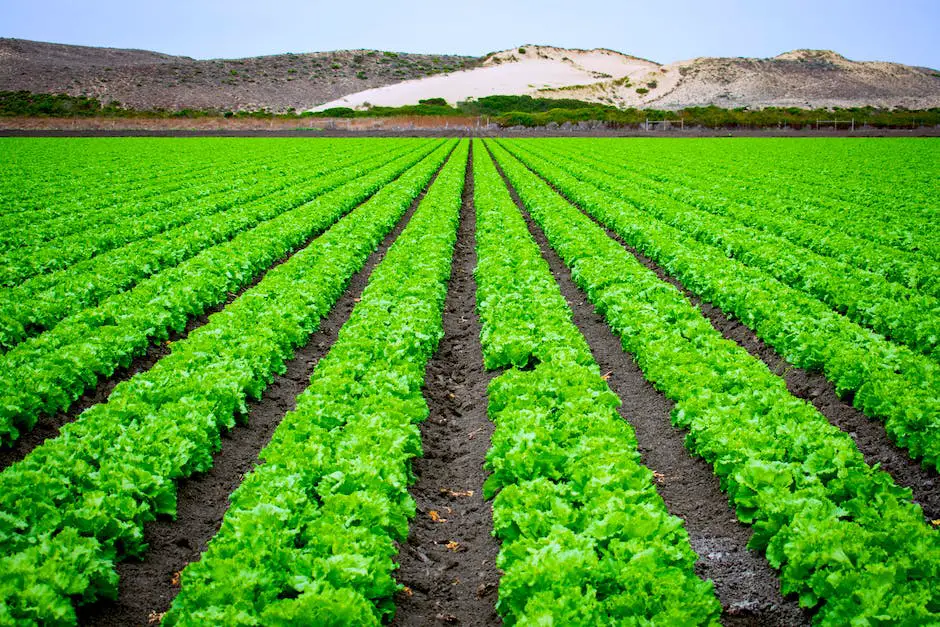Gardening has always been regarded as a productive and soothing activity, with its therapeutic benefits equalling the satisfaction of fresh harvests. Transforming a small balcony, sunny window sill, or patio into a thriving vegetable garden has never been easier with the practice of container gardening. Lettuce, a staple in kitchens across America, is a perfect candidate for container gardening due to its flexibility and simplicity to grow. This essay aims to guide you through the art of container lettuce gardening, from choosing the right container to mastering the essential care your garden needs to flourish. In particular, we’ll address concerns about appropriate drainage, depth, and materials of containers, share insights on selecting and planting lettuce that will thrive in your unique circumstances, and give you useful tips to maintain, fertilize, and successfully harvest from your lettuce garden.
Choosing the right container
Ahoy, lettuce gardening enthusiasts! We’re about to embark on an exciting journey. The topic might seem simple at first glance, but it carries more weight than you’d imagine: we’re delving into the world of containers for lettuce gardening. Perhaps one of the unsung heroes of gardening, containers can make or break a healthy lettuce crop. So, how exactly does one choose the ideal container? Let’s dive in!
Reader Poll: What online courses would interest you?
First and foremost, lettuce likes room to breathe. While that doesn’t mean it’s necessarily suited to sprawling planters, lettuce does want space to stretch, ideally in wide, shallow containers. Start by looking for pots and planters that are at least six to twelve inches in depth and have plenty room around the edges, you could go for something like a “window box” container for optimal space usage.
While you could technically grow lettuce in any material, each type carries with it pros and cons. Plastic containers, for example, can be incredibly lightweight and portable. They’re a popular choice, as they retain moisture well which lettuce loves. However, plastic doesn’t “breathe” and on particularly hot days, the soil could overheat and stress the lettuce.
Ceramic and clay pots on the other hand, are breathable and offer excellent temperature regulation. They can be heavy, which makes them stable but less easy to transport. Unfortunately, they’re prone to cracking in extreme weather. Also, these materials do not retain water as well as their plastic counterparts, so they may require more frequent watering.
Subscribe to our newsletter!
If it’s aesthetics you’re after alongside functionality, consider using wooden crates or barrel halves. Not only do these have ample space, but they also have fantastic drainage and look great in a garden setting. However, these may rot over time if not properly cared for.
Next, let’s talk about drainage. It’s essential to have multiple drainage holes in the bottom of your container. This prevents your lettuce from sitting in soggy soil for too long and developing root rot. Lettuce prefers damp, not soaking wet soil.
Finally, an ideal container is left partly shaded. Lettuce, while loving its sunlight, isn’t partial to extremely hot temperatures, but tolerates cool weather elegantly. Leaving your container in partial shade can help to shield the plant during scorching afternoon sun.
You see, selecting the appropriate container for your lettuce endeavor is a process worth giving attention. The right box, pot, or planter can be the difference between a lacklustre bed and a lush, appealing harvest. So, go ahead – start exploring and find your perfect container for lettuce gardening today!

Selecting and Planting the Lettuce
Choosing and Cultivating Lettuce for Container Gardening
Now that we have a firm grasp on the important role containers play in lettuce gardening, let’s delve into the specifics of selecting appropriate lettuce varieties, preparing your seeds, and nurturing them on their journey towards becoming crisp, juicy salad staples.
Choosing the Right Lettuce
Lettuce varieties are vast and diverse, but not all are well-suited to container gardening. While heading types, such as icebergs, are popular, they require more space and time to mature, making them less suitable for container cultivation. Instead, focus on loose-leaf and romaine varieties like ‘Salad Bowl,’ ‘Red Sails,’ ‘Little Gem,’ ‘Oak Leaf,’ and ‘Buttercrunch.’ These types are compact, speedy growers, perfect for containers and regular harvests.
Preparing Your Seeds
It’s rare to find a lettuces seed that isn’t high quality – they’re reliable cultivars. Consider buying pelleted seeds – these are seeds coated in an inert material, making them larger and easier to handle. Otherwise, traditional seeds are perfectly fine – you just need a little more finesse when planting.
Start by filling your container with a high-quality potting mix enriched with organic matter such as compost or well-rotted manure. Lettuces are heavy feeders, and this will ensure a steady supply of nutrients. Level the soil but avoid compressing it, we want those roots to breathe and stretch out!
Planting Your Seeds
Now, lightly sprinkle your seeds over the surface of the soil. No need for specific planting holes at this stage – the aim is to create a ‘sea of green’ covering the container’s surface. After spreading the seeds, lightly cover them with a sprinkling of soil – no deeper than 1/8 inch. Lettuce seeds need some light to germinate, so resist the urge to bury them too deep.
Watering and Care
Once the seeds are in place, moisten the soil gently with a spray bottle or a watering can equipped with a fine rose. A harsh flow of water can dislodge the seeds, threatening your future harvest.
In about 7-10 days, little green seedlings will begin to appear. Make sure to keep the soil consistently damp but not waterlogged. Overwatering can cause issues like damping off, a fungal disease where seedlings suddenly collapse and die.
Thinning Your Lettuce
Once the seedlings are an inch or so tall, it’s time to thin them out. Aim for roughly one plant every 4 inches, allowing enough space for the mature lettuces to grow without competing for resources. Thinned out seedlings can be eaten, so there’s no waste.
Celebrating Harvest
Within 4-6 weeks post germination, depending upon the variety, climate, and available nutrients, you can begin harvesting. Pick outer leaves on an ongoing basis or cut the entire plant off at soil level, leaving the root in place to regenerate for a second harvest.
And there you have it! From selecting the right variety to enjoying your homegrown salad, every step brings joy and fulfillment in the world of lettuce container gardening. It’s about patience, nurturing, observing, and above all, relishing the journey. Ready for planting? Happy gardening!

Caring for Your Container Lettuce Garden
Now that you’ve chosen your container, prepared your seeds, and have your little greens starting to sprout in their new homes, it’s critical that you follow up with proper care and attention. Your diligent work doesn’t end at planting, and your new hobby certainly isn’t a ‘bang-and-done’ affair. No, no! Let’s delve into the steps you need to take to ensure your lettuce garden thrives.
Firstly, never underestimate the power of a good watering routine. Lettuce is mostly water-based, thus ample hydration is crucial for your garden. However, take heed not to overwater, as this can lead to a host of problems like root rot and mildew. The key here is balance. The soil should be kept consistently moist but not waterlogged. In the warmer months, a daily watering should be sufficient, but make sure to adjust for changes in weather and conditions. Remember, life is a balancing act.
Once your baby lettuce plants have grown a few leaves, it’s time to thin them out. This might seem counterproductive, but trust me, it’s vital. Each lettuce plant needs ample space to flourish, otherwise, they will struggle to get the nutrients they need from the soil. By providing each plant with room to grow, you’re ensuring your lettuce garden is lush and productive. Don’t worry about the thinned out seedlings going to waste, either. They make a great addition to salads!
Oh, the joy of your first harvest! Lightly harvested leaves will grow back, allowing for continual yield throughout the season. But remember that your lettuce isn’t a perennial plant—it won’t keep growing forever. Once the plant sends up a flower stalk, it’s done for the season. At this time, celebrate your hard work and harvest the whole plant to enjoy.
This brings us to another important aspect: replanting and regenerating. Lettuce is a cool-weather crop, so you can enjoy multiple harvests in a season with a bit of planning. Once you’ve harvested a plant, replace it with a fresh seedling to maintain your cycle of lettuce supply.
Last but not least, remember to give your container lettuce some love. Fertilize them every few weeks with an all-purpose vegetable garden fertilizer, but ensure to follow the instructions carefully. More isn’t always better, especially when it comes to feeding our leafy friends.
There you have it, folks! Taking care of your container lettuce garden is as rewarding as it is straightforward. It’s an enjoyable journey, from planting to munching on your home-grown salads. So, let your green thumb shine and relish the satisfaction that comes with this lovely pastime.

With the right type of container and suitable lettuce type, coupled with substantial knowledge on planting, caring, and harvesting, container lettuce gardening can become your favorite pastime. The renewal cycle of lettuce allows for continuous harvest, providing not just a fresh supply of greens, but also a fulfilling and calming hobby. As we delve into the intricacies of pest and disease management, you realize that challenges in container gardening are all manageable and are part and parcel of the process. By persisting through these hiccups, you not only strengthen your container gardening skill set, but also experience the delights of reaping organic, home-grown produce. The knowledge you have gained from this exploration into container lettuce gardening will inspire many successful planting seasons to come, turning even the smallest of spaces into a vibrant, thriving garden.

